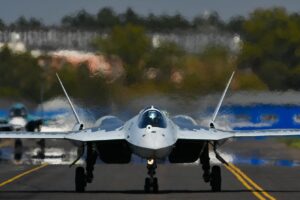 |
| Su-57 |
15 years ago, at the end of January 2010, the first flight of the Su-57 took place. At that time, it was designated as the PAK FA. What has it achieved to this day?
At the time, the head of Sukhoi, Mikhail Pogosyan, stated that the PAK FA would bring the Russian aviation industry to an entirely new technological level:
“These aircraft, along with modernized 4th-generation fighters, will determine the potential of the Russian Air Force for the coming decades.”
By 2025, the Ministry of Defense planned to purchase around 200 units. Additionally, large export orders were expected. India, which was involved in the PAK FA development project at the time, was supposed to acquire at least 100 aircraft.
However, as is often the case with expensive and complex military programs, things turned out differently. Delays and technical problems increasingly hindered the Su-57 development.
As a result, the first order for the serial modification was placed only in August 2018—for just two aircraft. The program only began to gain momentum in May 2019. It is expected that by 2028, a total of 76 aircraft will enter service with the Russian Aerospace Forces (VKS) thanks to optimized production processes and improved infrastructure.
The first Su-57 entered service in December 2020, but subsequent deliveries were slow. As of today, between 20 and 30 units are believed to be in operation.
The situation regarding exports remains unclear as well. India withdrew from the joint program long ago, but at the Chinese air show in Zhuhai in November 2024, it was announced that the first contracts with foreign buyers had been signed:
“The Su-57’s performance at the air show amazed the audience with its power and maneuverability.”
Russia has recently been using the Su-57 for high-risk missions aimed at suppressing enemy air defense systems. However, the main question now is when the fighter will receive its specially designed AL-51F engine. This engine was one of the main sticking points with India in addition to its limited role in design.
Despite all the challenges surrounding the Su-57, it represents “a significant leap in combat capabilities for the Russian Aerospace Forces.” The period between its first flight and its first delivery to the military was just under 10 years:
“Western models did not perform much better. For comparison: the prototype of the F-22 took off in September 1997, and the first combat unit received the new aircraft in January 2005. In Europe, the first Eurofighter prototype (DA1) flew in March 1994 and entered service in 2003.”
The Sukhoi Su-57, Russia’s fifth-generation stealth fighter, is designed to compete with advanced aircraft such as the American F-22 and F-35, as well as the Chinese J-20 and J-35. Its advantages lie in several key areas that highlight its evolving capabilities.
One of the most significant strengths of the Su-57 is its advanced firepower and weaponry. The aircraft is equipped with the latest Russian missiles, which have demonstrated high effectiveness in combat scenarios. With a long firing range, the Su-57 can engage targets at distances up to twice that of its American and Chinese counterparts. Additionally, its internal weapons bays allow it to carry a diverse array of munitions while maintaining stealth, including long-range air-to-air missiles and precision-guided bombs.
Maneuverability is another area where the Su-57 excels. Engineered for exceptional agility, it features thrust vectoring engines and advanced flight control systems that enable high angles of attack maneuvers. This design enhances its combat effectiveness in dogfights and allows for evasive actions against enemy fire. The ability to perform complex aerial maneuvers gives the Su-57 a tactical edge over its competitors.
Stealth and low observability are critical components of the Su-57’s design. The aircraft incorporates features that reduce its radar signature, enabling it to operate undetected in hostile environments. This capability is essential for penetrating advanced air defense systems, which are prevalent in modern warfare.Furthermore, the Su-57 is equipped with cutting-edge avionics and sensors, including the N035 Irbis radar and sophisticated electronic warfare systems. These advanced systems provide superior situational awareness, enhancing target tracking capabilities in complex operational environments and allowing pilots to engage threats more effectively.
An important aspect of the Su-57’s advantage is its potential for evolution. It is positioned as a platform for future upgrades, similar to the legacy Su-27 fighter. Ongoing tests are integrating new types of missiles and weapons systems, indicating that the aircraft will continue to evolve technologically. This adaptability ensures that it can meet future combat requirements and maintain relevance against emerging threats.
Lastly, unlike many of its competitors, the Su-57 has been tested in real combat situations, providing valuable data that informs ongoing development and enhancements. This operational experience contributes to its credibility as a formidable fighter jet on the global stage.
Su-57 is evolving to incorporate elements of sixth-generation technology while other nations are still in the process of designing new aircraft. According to a high-ranking official from Russia’s United Aircraft Corporation (UAC), the Su-57 was developed with a long-term modernization perspective, allowing for the integration of advanced technologies over time. This includes features that may align with sixth-generation capabilities, such as modular systems, multi-spectral stealth, and enhanced combat networking.
The Su-57’s ability to integrate sixth-generation features while remaining in service contrasts with the more traditional approach taken by other nations, which may require longer timelines for the development and deployment of new aircraft.
Official Website of Youtube Channel – Altitude Addicts

